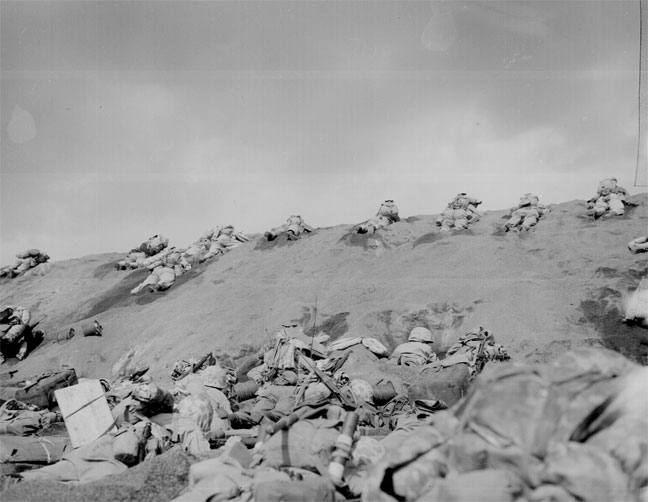FEBRUARY 19th 1945
US Forces Land On Iwo Jima

Marines of the 5th Division inch their way up a slope on Red Beach No. 1 toward Surbachi Yama
US forces landed on Iwo Jima, 750 miles south of Tokyo. The landings were heavily opposed by the Japanese, who fought to the death. Nevertheless, the US marines overwhelmed the defenders in a very hard fought battle that lasted for almost 30 days. It was one of the most bloody battles of the war.American planners decided to capture the island of Iwo Jima, believing its airfields would serve as an excellent place for the long range B-29’s to land if they were in trouble. The expectation that capturing the island would not be difficult. The Americans had overwhelming control of the sea and the air and would be able to support the landing without interference. The Japanese were under no illusions that they would be able to stop the Americans, their whole goal was to delay the Americans from advancing on the Japanese home islands.
On June 15, 1944 the US began naval bombardment and air raids against Iwo Jima. On February 18th, 1945 a massive US fleet bombarded the island. While it caused damage the 21,000 Japanese troops where well entrenched in extensive underground tunnels.
On February 19th, US Marines landed on the beach. The Japanese allowed the marines without interference. After a large number of them had landed the Japanese opened up on the beach with hidden artillery pieces on Mount Suribachi which dominated the beach. The artillery would fire and then return to hidden position so as not to hit by counter-fire. By the end of the first day the American forces managed to reach the edge of what was designated as Airfield 1. One unit managed to cross the whole island by the first night thus cutting the island in two. The Japanese continued to resist fiercely. On February 23rd American troops finally fought there way to the summit of Mount Suribachi, resulting in one of the most iconoclast pictures of the war the raising of the American flag on the summit.
Fighting did not end with the flag raising and US forces were forced to clear Japanese bunkers one at a time, often using flame throwers mounted on tanks to destroy the Japanese emplacements.
It took until March 26th for the island to be declared secure. Of the 21,000 Japanese who started the battle only 216 were captured, with another 3000 hiding in caves for various periods of time the last surrendering in 1949. The Americans suffered 26,000 casualties of which 6,800 were killed. In retrospect the cost of capturing Iwo Jima was too high, for an island that provided little strategic value.
 >
>